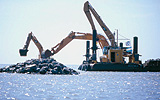Work resumes on Bystroe Canal
ICPDR Danube Watch: Work resumes on Bystroe Canal

Work resumes on Bystroe Canal
 Despite findings that the canal will have a significant impact on wildlife in the area, work continues on the Bystroe Canal.
Despite findings that the canal will have a significant impact on wildlife in the area, work continues on the Bystroe Canal. Work on the Bystroe Canal resumed on November 4th, with the dredger Tsuryupinsk returning to the Ukrainian Danube Delta to renew areas already dredged under the first phase of the project, which had silted in following initial dredging in 2004.
The work comes despite the report issued this summer by the Inquiry Commission of the United Nations Economic Commission for Europe. In the report, the commission unanimously concluded that the canal will have “significant adverse transboundary effects” on the environment. The canal will cause “large-scale, long-term cumulative impacts on fish and bird life from shipping traffic” and habit loss and destruction, said the commission.
According to the commission’s report, dredging will have an impact on the water level dynamics along the Bystroe branch that will result in the loss of floodplain habitats, which are used by fish for spawning and nurseries, and by birds for nesting and feeding. Furthermore, the commission found “the increase in suspended sediment concentrations downstream of the dredging site will harm fish”.
Ukraine developed the canal without notifying Romania, as required by the ESPOO Convention on Environmental Impact Assessment in a Transboundary Context and triggered the dispute resolution mechanism under the convention. The convention requires countries to notify each other on all planned projects that are likely to have a significant negative environmental impact across a national border.





